3010
IEEE TRANSACTIONS ON SIGNAL PROCESSING, VOL. 53, NO. 8, AUGUST 2005
A Sparse Signal Reconstruction Perspective for
Source Localization With Sensor Arrays
Dmitry Malioutov, Student Member, IEEE, Müjdat Çetin, Member, IEEE, and Alan S. Willsky, Fellow, IEEE
Abstract—We present a source localization method based on a
sparse representation of sensor measurements with an overcom-
plete basis composed of samples from the array manifold. We
enforce sparsity by imposing penalties based on the 1-norm. A
number of recent theoretical results on sparsifying properties of
1 penalties justify this choice. Explicitly enforcing the sparsity
of the representation is motivated by a desire to obtain a sharp
estimate of the spatial spectrum that exhibits super-resolution.
We propose to use the singular value decomposition (SVD) of the
data matrix to summarize multiple time or frequency samples.
Our formulation leads to an optimization problem, which we solve
efficiently in a second-order cone (SOC) programming framework
by an interior point implementation. We propose a grid refinement
method to mitigate the effects of limiting estimates to a grid of
spatial locations and introduce an automatic selection criterion
for the regularization parameter involved in our approach. We
demonstrate the effectiveness of the method on simulated data by
plots of spatial spectra and by comparing the estimator variance to
the Cramér–Rao bound (CRB). We observe that our approach has
a number of advantages over other source localization techniques,
including increased resolution,
improved robustness to noise,
limitations in data quantity, and correlation of the sources, as well
as not requiring an accurate initialization.
Index Terms—Direction-of-arrival estimation, overcomplete
representation, sensor array processing, source localization,
sparse representation, superresolution.
I. INTRODUCTION
S OURCE localization using sensor arrays [1], [2] has been
an active research area, playing a fundamental role in many
applications involving electromagnetic, acoustic, and seismic
sensing. An important goal for source localization methods is
to be able to locate closely spaced sources in presence of con-
siderable noise. Many advanced techniques for the localization
of point sources achieve superresolution by exploiting the pres-
ence of a small number of sources. For example, the key com-
ponent of the MUSIC method [3] is the assumption of a low-di-
mensional signal subspace. We follow a different approach for
exploiting such a structure: We pose source localization as an
overcomplete basis representation problem, where we impose a
penalty on the lack of sparsity of the spatial spectrum.
Our approach is distinctly different from the existing source
localization methods, although it shares some of their ingre-
dients. The most well-known existing nonparametric methods
Manuscript received April 26, 2004; revised November 5, 2004. This work
was supported by the Army Research Office under Grant DAAD19-00-1-0466
and the Air Force Office of Scientific Research under Grant F49620-00-1-0362.
The associate editor coordinating the review of this manuscript and apporovng
it for publication was Dr. Jean Pierre Delmas.
The authors are with the Department of Electrical Engineering and Computer
Science, Massachusetts Institute of Technology, Cambridge, MA 02139 USA.
Digital Object Identifier 10.1109/TSP.2005.850882
include beamforming [2], Capon’s method [4], and subspace-
based methods such as MUSIC [3]. Some additional methods
(Root-MUSIC and ESPRIT) [1] require the assumption that the
array of sensors is linear. Beamforming spectrum suffers from
the Rayleigh resolution limit, which is independent of the SNR.
MUSIC and Capon’s method are able to resolve sources within
a Rayleigh cell (i.e., achieve super-resolution), provided that the
SNR is moderately high, the sources are not strongly correlated,
and the number of snapshots is sufficient. A family of parametric
methods based on the maximum likelihood paradigm, including
deterministic maximum likelihood (DML) and stochastic max-
imum likelihood (SML) [1], enjoy excellent statistical proper-
ties, but an accurate initialization is required to converge to a
global minimum. By turning to the sparse signal representation
framework, we are able to achieve super-resolution without the
need for a good initialization, without a large number of time
samples, and with lower sensitivity to SNR and to correlation
of the sources.
-norm penalty with
The topic of sparse signal representation has evolved very
rapidly in the last decade, finding application in a variety of
problems, including image reconstruction and restoration [5],
wavelet denoising [6], feature selection in machine learning [7],
radar imaging [8], and penalized regression [9]. There has also
been some emerging investigation of these ideas in the context
of spectrum estimation and array processing [10]–[14]. Sacchi
et al. [10] use a Cauchy-prior to enforce sparsity in spectrum
estimation and solve the resulting optimization problem by iter-
to
ative methods. Jeffs [11] uses an
enforce sparsity for a number of applications, including sparse
antenna array design. Gorodnitsky et al. [12] apply a recur-
sive weighted minimum-norm algorithm called focal underde-
termined system solver (FOCUSS) to achieve sparsity in the
problem of source localization. It was later shown [15] that
penalties with
the algorithm is related to the optimization of
. The work of Fuchs [13], [14] is concerned with source
localization in the beamspace domain, under the assumption
that the sources are uncorrelated, and that a large number of
time samples is available. The method attempts to represent the
vector of beamformer outputs to unknown sources as a sparse
linear combination of vectors from a basis of beamformer out-
puts to isolated unit power sources. The method uses the
penalty for sparsity and the
penalty for noise. Prior research
has established sparse signal representation as a valuable tool
for signal processing, but its application to source localization
has been developed only for very limited scenarios. We start
with the ideas of enforcing sparsity by
penalties and extend
them to a general framework that is applicable to a wide variety
of practical source localization problems.
In its most basic form, the problem of sparse signal repre-
sentation in overcomplete bases asks to find the sparsest signal
1053-587X/$20.00 © 2005 IEEE
�
MALIOUTOV et al.: SPARSE SIGNAL RECONSTRUCTION PERSPECTIVE FOR SOURCE LOCALIZATION WITH SENSOR ARRAYS
3011
, where
to satisfy
basis, i.e.,
is an overcomplete
. Without the sparsity prior on , the problem
is ill-posed and has infinitely many solutions. Addi-
should be sufficiently sparse allows
tional information that
one to get rid of the ill-posedness. Solving problems involving
sparsity typically requires combinatorial optimization, which is
intractable even for modest data sizes; therefore, a number of re-
laxations have been considered [16]–[19]. We give a brief syn-
opsis of relevant ideas in sparse signal representation in Sec-
tion II.
The application of this methodology to practical array
processing problems requires being able to handle additive
noise, using multiple time or frequency samples from possibly
strongly correlated sources in a sensible fashion, and allowing
the data to be complex:
(1)
The goal of this paper is to explore how to utilize the sparse
signal representation methodology for practical narrowband
and wideband source localization using sensor arrays. The
main contributions of our paper include a new adaptation of
sparse signal representation to source localization through
the development of an approach based on the singular value
decomposition (SVD) to combine multiple samples and the
use of second-order cone programming for optimization of
the resulting objective function. The key ingredients of the
proposed method is the use of SVD for data reduction and the
formulation of a joint multiple-sample sparse representation
problem in the signal subspace domain. In the body of the
-SVD. In addition, we
paper, we refer to the method as
introduce the idea of adaptive grid refinement to combat the
effects of a bias introduced by a limitation of the estimates to a
grid. Finally, we discuss a method for the automatic selection
of the regularization parameter involved in our approach, which
-SVD objective.
balances data-fidelity with sparsity in the
In our experiments, the proposed approach exhibits a number
of advantages over other source localization techniques, which
include increased resolution, and improved robustness to noise,
to limited number of snapshots, and to correlation of the
sources. In addition, due to the convexity of all the optimization
tasks involved in the approach, it does not require an accurate
initialization. Another advantage of the approach is its flexi-
bility, since few assumptions are made in the formulation, e.g.,
the array does not have to be linear, and the sources may be
strongly correlated. Similarly, extensions to many scenarios,
such as distributed sources and non-Gaussian noise, can be
readily made. In the paper, we mostly focus on the narrow-
band farfield problem with arbitrary array geometry; we also
describe the wideband scenario briefly in Section VIII-D. A
more extensive discussion can be found in [20], where we also
consider beamspace versions, cover wideband and nearfield
processing in more detail, and propose an approach for simul-
taneous self-calibration and source localization in the presence
of model errors.
We start with a brief introduction to the problem of sparse
signal representation in Section II. In Section III, we describe
the source localization problem and represent a single sample
problem directly in the sparse signal representation framework.
In Section IV, we extend the approach to handle multiple sam-
ples. This is done in several steps, leading to the
-SVD tech-
nique. In Section V, we describe how to find numerical solutions
via a second-order cone programming (SOC) framework. We
describe how to eliminate the effects of the grid in Section VI
and propose how to automatically choose a regularization pa-
rameter involved in our approach in Section VII. Finally, in Sec-
tion VIII, the advantages and disadvantages of the framework
are explored using simulated experiments, and conclusions are
made in Section IX.
II. SPARSE SIGNAL REPRESENTATION
, given
, with
. The matrix
, which we also call the
The simplest version of the sparse representation problem
,
without noise is to find a sparse
which are related by
is known. The assumption of sparsity of
problem is ill-posed without it (
An ideal measure of sparsity is the count of nonzero entries
which is denoted by
Hence, mathematically, we must look for arg min
is crucial since the
has a nontrivial null-space).
,
-norm.1
such that
. This is, however, a difficult combinatorial optimiza-
tion problem and is intractable for even moderately sized prob-
lems. Many approximations have been devised over the years,
including greedy approximations (matching pursuit, stepwise
regression, and their variants [17], [19]), as well as
re-
laxations, where
, for
, [20]. For the latter two, it has been shown recently that
if
, then these approxi-
mations in fact lead to exact solutions (see [18], [20]–[24] for
precise definitions of these notions).2 In addition, [26] and [27]
showed that with sufficient sparsity and a favorable structure of
the overcomplete basis, sparse representations are stable in the
presence of noise. These results are practically very significant
is a convex
since the
optimization problem, and the global optimum can be found for
real-valued data by linear programming.3 As these equivalence
results are not specialized to the source localization problem but
are derived for general overcomplete bases, the bounds that they
provide are loose. A result that does take the structure of the
basis into account is developed in [28].
is “sparse enough” with respect to
is replaced by
, [16], and
relaxation
subject to
and
In practice, a noiseless measurement model is rarely appro-
priate; therefore, noise must be introduced. A sparse represen-
tation problem with additive Gaussian noise takes the following
form:
(2)
To extend
choice of an optimization criterion is
-penalization to the noisy case, an appropriate
subject to
is a parameter specifying how
, where
1The symbols kxk and kxk are both used in the literature to represent the
count of nonzero elements. We use the latter symbol since in the limit as p !
0 ; kxk approaches the count of nonzero elements, but, if x 6= 0 kxk !
1.
2Recent studies of greedy methods, which have lower complexity than ` and
` -based methods, have also yielded theoretical results of a similar flavor [25],
[26].
3In addition, for the ` problem, local minima can be readily found by con-
tinuous optimization methods, as described in [20].
�
3012
IEEE TRANSACTIONS ON SIGNAL PROCESSING, VOL. 53, NO. 8, AUGUST 2005
much noise we wish to allow. An unconstrained form of this
objective is
(3)
This objective function has been used in a number of sparse
signal representation works ([16], [29] for real-valued data and
-term forces the residual
[30] for complex-valued data). The
-term enforces sparsity of the
to be small, whereas the
representation. The parameter
controls the tradeoff between
the sparsity of the spectrum and the residual norm. We use these
ideas in Sections III and IV for source localization.
The optimization criterion is again a convex optimization
problem and can be readily handled by quadratic programming
for real data. We propose the use of SOC programming for
the complex data case. We describe SOC programming in
Section V.
. However, for
penalty instead of
The class of methods called FOCUSS [12] is another par-
adigm for solving sparse signal representation problems with
,
a more general
the cost function is nonconvex, and the convergence to global
minima is not guaranteed. The discussion in [15] in Section VI
indicates that the best results are obtained for
close to 1,
whereas the convergence is also slowest for
. The cost per
iteration for FOCUSS methods is similar to that of an interior
point solver for SOC since both solve a modified Newton’s
method step of similar dimensions. However, the number of
iterations of SOC is better behaved (in fact, there are bounds
on the worst-case number of iterations for SOC [31]) than for
FOCUSS with
. In our previous work [20], we have
also observed slow convergence of iterative algorithms for
. By using an SOC
minimization when applied with
formulation that is tailored to the convex
case, we are able
to achieve fast convergence and guarantee global optimality of
the solution.
III. SOURCE LOCALIZATION FRAMEWORK
A. Source Localization Problem
The goal of sensor array source localization is to find the lo-
cations of sources of wavefields that impinge on an array con-
sisting of a number of sensors. The available information is
the geometry of the array, the parameters of the medium where
wavefields propagate, and the measurements on the sensors.
For purposes of exposition, we first focus on the narrow-
band scenario and delay the presentation of wideband source
localization until Section VIII-D. Consider
narrowband sig-
nals
om-
nidirectional sensors, after being corrupted by additive noise
. Let
.
After demodulation, the basic narrowband observation model
can be expressed as [1], [2]
, resulting in sensor outputs
, arriving at an array of
and similarly define
and
(4)
The matrix
is the so-called array manifold matrix, whose
th element contains the delay and gain information from
th sensor. The columns
) to the
the th source (at location
of
, for
, are called steering vec-
tors. The number of sources
is unknown. To simplify the ex-
position, we only discuss the farfield scenario and confine the
array to a plane, although neither of these assumptions is re-
quired for our approach. With farfield sources in the same plane
as the array, the unknown locations of the sources are parame-
terized by angles (directions of arrival) with respect to the array
and the
axis
mapping
, the goal is to find the unknown locations
of the sources
. Given the knowledge of
, as well as their number
for all
.
B. Overcomplete Representation for a Single Time Sample
Now, we start to formulate the source localization problem as
a sparse representation problem. The single-sample formulation
in this section parallels the one in [12], where it was presented
as one of applications of FOCUSS algorithm. In addition, the
work in [13] and [14] is based on a similar philosophy of trans-
forming a parameter estimation problem into sparse spectrum
estimation, which we discuss later in this section.
We consider the single time sample case in this section, with
in (4). The problem as it appears in (4) is a nonlinear pa-
rameter estimation problem, where the goal is to find . Matrix
, so it is not
depends on the unknown source locations
known.
To cast this problem as a sparse representation problem,
we introduce an overcomplete representation
in terms of
all possible source locations. Let
be a sam-
pling grid of all source locations of interest. The number of
potential source locations
will typically be much greater
or even the number of sensors
than the number of sources
. We construct a matrix composed of steering vectors cor-
responding to each potential source location as its columns:
is known
. In this framework
and does not depend on the actual source locations .
We represent the signal field by an
vector
, where
the th element
comes from for some
sample, the problem is reduced to
is nonzero and equal to
if source
and zero otherwise. For a single time
(5)
In effect,
this overcomplete representation allows us to
for the
exchange the problem of parameter estimation of
problem of sparse spectrum estimation of
. As in numerous
nonparametric source localization techniques, the approach
forms an estimate of the signal energy as a function of hypoth-
esized source location, which ideally contains dominant peaks
at the true source locations. The central assumption is that the
sources can be viewed as point sources, and their number is
small. With this assumption, the underlying spatial spectrum
is sparse (i.e.,
has only a few nonzero elements), and we can
solve this inverse problem via regularizing it to favor sparse
signal fields using the
methodology, as described in Sec-
tion II. The appropriate objective function for the problem is
We discuss how is chosen in Section VII, but for now, we as-
sume that a good choice can be made. The data for the model
(6)
�
MALIOUTOV et al.: SPARSE SIGNAL RECONSTRUCTION PERSPECTIVE FOR SOURCE LOCALIZATION WITH SENSOR ARRAYS
3013
a penalty that enforces the same sparsity profile over all these
vectors, thus imposing temporal coherence. The resulting for-
mulation is considerably more general than the one in [14].
IV. SOURCE LOCALIZATION WITH MULTIPLE
TIME SAMPLES AND -SVD
Single snapshot processing may have its own applications,
but source localization with multiple snapshots4 from poten-
tially correlated sources is of greater practical importance.
When we bring time into the picture, the overcomplete repre-
sentation is easily extended. The general narrowband source
localization problem with multiple snapshots reformulated
using an overcomplete representation has the following form:
(7)
However, the numerical solution of this problem is a bit more
involved than that of the single sample case. In Section IV-A,
we describe a simple and computationally efficient method that,
however, does not use the snapshots in synergy. In Section IV-B,
we propose a coherent method that does use the snapshots in
synergy but is more demanding computationally, and in Sec-
tion IV-C, we develop an SVD-based approach that dramati-
cally reduces the computational complexity while still using the
snapshots coherently.
A. Treating Each Time Index Separately
The first thought that comes to mind when we switch from
one time sample to several time samples is to solve each problem
indexed by separately. In that case, we would have a set of
solutions
. If the sources are moving fast, then the evolution
of
is of interest, and the approach is suitable for displaying
it. However, when the sources are stationary over several time
samples, then it is preferable to combine the independent esti-
mates
to get one representative estimate of source locations
from them, for example, by averaging or by clustering. This is
noncoherent averaging, and its main attraction is its simplicity.
However, by turning to fully coherent combined processing, as
described in the following sections, we expect to achieve greater
accuracy and robustness to noise.
B. Joint-Time Inverse Problem
Now, we consider a simple approach that uses different time
samples in synergy. Let
and
similarly. Then, (7) becomes
, and define
(8)
There is an important difference of (8) from (5): Matrix
is
parameterized temporally and spatially, but sparsity only has to
be enforced in space since the signal
in not generally sparse
in time. To accommodate this issue, we impose a different prior:
one that requires sparsity in the spatial dimension but does not
require sparsity in time. This can be done5 by first computing the
,
-norm of all time-samples of a particular spatial index of
4While here we focus on multiple time snapshots, we will also use the same
ideas applied to frequency snapshots for wideband source localization in Sec-
tion VIII.
5It came to our attention that a similar idea has been used in [30] for basis
selection.
Fig. 1. Single sample source localization with ` . Spatial spectra of two
sources with DOAs of 60 and 70 (SNR = 20 dB).
is complex-valued; hence, neither linear nor quadratic program-
ming can be used for numerical optimization. Instead, we adopt
an SOC programming framework, which we introduce in Sec-
tion V. Once
is found, the estimates of the source locations
correspond to the locations of the peaks in .
We illustrate the approach for source localization with a
single time sample in Fig. 1. We consider a uniform linear
array of
sensors separated by half a wavelength of the
actual narrowband source signals. We consider two narrowband
signals in the far-field impinging on this array from directiions
of arrival (DOAs) 60 and 70 , which are closer together than
the Rayleigh limit. The SNR is 20 dB. The regularization
parameter
in this example is chosen by subjective assess-
ment. We do not consider other source localization methods
such as MUSIC or Capon’s method in this simulation because
they rely on estimating the covariance matrix of the sensor
measurements, but in the simulation only, one time sample is
present. Using beamforming, the two peaks of the spectrum
are merged, but using the sparse regularization approach, they
are well resolved, and the sidelobes are suppressed almost to
zero. Apart from a small asymptotic bias, which we discuss
in Section VIII, the spectrum estimate is an example of what
super-resolution source localization methods aim to achieve.
The work of Fuchs [13], [14] is based on a similar philosophy
of transforming a parameter estimation problem into a sparse
spectrum estimation problem. A basis composed of beamformer
outputs to isolated unit power sources from a large number of
directions is created first. The method then attempts to represent
the vector of beamformer outputs corresponding to the unknown
sources as a sparse linear combination of vectors from the basis,
using
penalties for noise, and opti-
mization by quadratic programming. However, this beamspace
domain formulation combines the multiple snapshots in a way
that requires assumptions that the sources are uncorrelated and
that a large number of samples is available. In contrast, the
sensor-domain method that we propose in Section IV-C treats
the multiple time samples in a very different way: We sum-
marize multiple snapshots by using the SVD and solve a joint
optimization problem over several singular vectors, imposing
penalties for sparsity,
�
3014
i.e.,
-norm of
, and penalizing the
. The cost function becomes
(9)
The Frobenius norm is defined as
. The optimization is performed over
vec
is a function of
. The time samples are combined using the
2-norm, which has no sparsifying effects. The spatial samples
-norm, which does enforce sparsity.
are combined using the
Compared to the independent sample by sample processing
from Section IV-A, the different time-indices of
reinforce
each other, since the penalty is higher if the supports of
for different do not line up exactly. Once an estimate of
computed using the new cost function, the peaks of
the source locations.
is
provide
The main drawback of this technique is its computational
cost. The size of the inverse problem increases linearly with
, and the computational effort required to solve it increases
is large, this approach is
superlinearly with
not viable for the solution of the real-time source localization
problem. We propose a solution to this problem next.
. Thus, when
C.
-SVD
In this section, we present a tractable approach to use a large
number of time samples coherently, thus extending the use of
sparse signal representation ideas for practical source localiza-
tion problems. To reduce both the computational complexity
and the sensitivity to noise, we use the SVD of the
data
matrix
. The idea is to decompose the
data matrix into the signal and noise subspaces, keep the signal
subspace, and mold the problem with reduced dimensions into
the multiple-sample sparse spectrum estimation problem in the
form of Section IV-B. Note that we keep the signal subspace and
not the noise subspace, which gets used in MUSIC, Pisarenko,
and the minimum norm subspace methods.
Without noise on the sensors, the set of vectors
vectors instead of
-dimensional subspace, where
would lie in a
is the number
of sources.6 We would only need to keep a basis for the subspace
(
) to estimate what sparse combinations
form it. With additive noise, we decompose the
of columns of
data matrix into its signal and noise subspaces and keep a basis
for the signal subspace. Mathematically, this translates into the
following representation. Take the SVD7
dimensional matrix
Keep a reduced
tains most of the signal power
where
is a
and
, to obtain
. Here,
matrix of zeros. In addition, let
is a
identity matrix, and
(10)
, which con-
,
,
(11)
6If T < K, or if the sources are coherent, we use the number of signal
subspace singular values instead of K.
7This is closely related to the eigen-decomposition of
the correla-
tion matrix of the data: R = 1=T YY . Its eigen-decomposition is
R = 1=T ULV VL U = 1=T UL U .
IEEE TRANSACTIONS ON SIGNAL PROCESSING, VOL. 53, NO. 8, AUGUST 2005
Fig. 2. Block diagram of steps for ` -SVD.
Now, let us consider this equation column by column (each
column corresponds to a signal subspace singular vector):
(12)
This is now in exactly the same form as the original multiple
time sample problem (7), except that instead of indexing sam-
ples by time, we index them by the singular vector number.
What we have achieved by bringing the SVD transformation
into the picture is the reduction of the size of the problem in Sec-
tion IV-B from blocks of data to
is the number
of sources. For typical situations where the number of sources
is small and the number of time samples may be in the order of
hundreds, this reduction in complexity is very substantial.
, where
If we think of
as a two-dimensional (2-D) field, indexed
in terms of the singular
by in the spatial dimension, and by
vector index, then we again want to impose sparsity in
only spatially (in terms of
vector index . Similarly to Section IV-B, we define
. The sparsity of the resulting
) and not in terms of the singular
vector
We can find the spatial spectrum of by minimizing
corresponds to the sparsity of the spatial spectrum.
(13)
We illustrate the steps for the
-SVD method in Fig. 2.
Note that our formulation uses information about the number
of sources
. However, we empirically observe that incorrect
determination of the number of sources in our framework has no
catastrophic consequences (such as complete disappearance of
some of the sources as may happen with MUSIC) since we are
not relying on the structural assumptions of the orthogonality
of the signal and noise subspaces. Underestimating or overes-
timating manifests itself only in gradual degradation of per-
formance. This is illustrated in Section VIII.
V. SOC REPRESENTATION OF THE
-SVD PROBLEM
Now that we have an objective function in (13) to minimize,
we would like to do so in an efficient manner. The objective
contains a term
, which
is neither linear nor quadratic. We turn to SOC programming
[32], which deals with the so-called SOC constraints of the form
. SOC
programming is a suitable framework for optimizing functions
, i.e.,
�
MALIOUTOV et al.: SPARSE SIGNAL RECONSTRUCTION PERSPECTIVE FOR SOURCE LOCALIZATION WITH SENSOR ARRAYS
3015
that contain SOC, convex quadratic, and linear terms. The main
reason for considering SOC programming instead of generic
nonlinear optimization for our problem is the availability of ef-
ficient interior point algorithms for the numerical solution of the
former, e.g., [33]. In addition to efficient numerical solution,
SOC programming has a substantial theoretical foundation as
a special case of semidefinite programming and convex conic
programming. See [32] for details; we describe in the Appendix
how to manipulate the problem in (13) into the SOC program-
ming form:
subject to
where
and
and
for
for
(14)
Fig. 3.
Illustration of grid refinement.
For the numerical solution of our SOC problem, we use a
package for optimization over self-dual homogeneous cones
(which includes direct products of the positive orthant-con-
straints, SOC constraints, and semidefinite cone constraints),
called SeDuMi [33]. In terms of computational complexity, the
interior point method relies on iterations of modified Newton’s
method. One of the main attractions of interior point methods
is that the number of these iterations typically stays quite
low, independent of the size of the problem. For optimizing
-SVD objective function in SOCP framework using an
the
interior point implementation, the cost8 is
with the observation that the number of iterations is empir-
ically almost independent of the size of the problem [31] (a
theoretical worst-case bound on the number of iterations is
[31]). The computational complexity is higher
than that of [14] since we have a joint optimization problem
over
singular vectors, leading to an additional factor of
. It is also higher than the cost of MUSIC, where the main
complexity is in the subspace decomposition of the covariance
matrix, which is
. However, the benefit that we get in
return is generality. For reference, for a problem with three
sources impinging upon an array with eight sensors and having
1 sampling of the spatial location of the sources (180 points
on the grid), the time required for optimization using a Matlab
implementation of the code on Linux on a computer with an
800-MHz Pentium 3 processor is roughly 5 sec, with around
20 iterations.
VI. MULTIRESOLUTION GRID REFINEMENT
Thus far, in our framework, the estimates of the source lo-
cations are confined to a grid. We cannot make the grid very
fine uniformly since this would increase the computational com-
plexity significantly. We explore the idea of adaptively refining
the grid in order to achieve better precision. The idea is a very
natural one: Instead of having a universally fine grid, we make
the grid fine only around the regions where sources are present.
This requires an approximate knowledge of the locations of the
8We assume that M � N .
sources, which can be obtained by using a coarse grid first. The
algorithm is as follows.
1) Create a rough grid of potential source locations
, for
. The grid should not be too
rough in order to not introduce substantial bias. A 1 or
2 uniform sampling usually suffices.
. Set
2) Form
, where
.
Use our method from Section IV-C to get the estimates of
the source locations
.
around the locations of the peaks,
3) Get a refined grid
, and set
. We specify how this is done below.
, for
4) Return to step 2 until the grid is fine enough.
Many different ways to refine the grid can be imagined; we
choose simple equispaced grid refinement. Suppose we have
a locally uniform grid (piecewise uniform), and at step , the
spacing of the grid is
. We pick an interval around the th peak
of the spectrum, which includes two grid spacings to either side,
i.e.,
. In the intervals
around the peaks, we select the new grid whose spacing is a frac-
tion of the old one
. It is possible to achieve fine
grids either by rapidly shrinking
for a few refinement levels
or by shrinking it slowly using more refinement levels. We find
that the latter approach is more stable numerically; therefore, we
typically set
. After a few (e.g., 5) iterations of refining
the grid, it becomes fine enough that its effects are negligible.
Fig. 3 illustrates the refinement of the grid. The spacing of each
of the grids corresponds to
. The idea has been successfully
used for some of the experimental analysis we present in Sec-
tion VIII.
VII. REGULARIZATION PARAMETER SELECTION
An important part of our source localization framework is the
choice of the regularization parameter
in (13), which balances
the fit of the solution to the data versus the sparsity prior. The
same question arises in many practical inverse problems and
is difficult to answer in many cases, especially if the objective
function is not quadratic. We discuss an approach to select the
regularization parameter automatically for the case where some
�
3016
IEEE TRANSACTIONS ON SIGNAL PROCESSING, VOL. 53, NO. 8, AUGUST 2005
statistics of the noise are known or can be estimated. Let us
as
denote the estimate of the spatial spectrum obtained using
the regularization parameter by
. A well-known idea under
the name of discrepancy principle [34] is to select
to match
the residuals of the solution
to some known statistics of the
noise when such are available. For example, if the distribution of
is known or can be modeled, then one can select
the noise
. Here, the we use the
. Directly searching for a
to achieve the equality is rather difficult and requires
Frobenius norm
value of
solving the problem (13) multiple times for different
such that
vec
s.
Instead, we propose to look at the constrained version of the
problem in (13), which can also be efficiently solved in the SOC
framework [20]:
subject to
(15)
vec
. If
distribution with
has approximately a
high enough so that the probability that
The problem in (15) is equivalent via Lagrange multipliers to
the one in (13) for some parameter
, which is related to .
For the problem in (15), the task of choosing the regulariza-
tion parameter
properly is considerably more transparent: We
choose
is
small, where
is independent and iden-
tically distributed (i.i.d.) Gaussian, then for moderate to high
SNR,
de-
grees of freedom upon normalization by the variance of
. The
reason that this holds only approximately is that the SVD in
(10)
depends on the particular re-
alization of noise, and hence, the matrix
is a function of
.
However, when noise is small, the term
dominates the SVD,
and the change due to the addition of
is small, and we arrive
at a
. With the knowledge of the dis-
and use
tribution, we can find a confidence interval for
its upper value as a choice for
. In simulations we present in
Section VIII, we find that this procedure generates appropriate
regularization parameter choices for our problem when noise
is reasonably small. We also present some thoughts on how to
extend the range of the applicability of the procedure to higher
levels of noise by characterizing the distribution of
for lower
SNR.
distribution for
When noise statistics are not known, and no knowledge of the
number of sources is available, the choice of the regularization
parameter is a difficult question. It has been approached in the
inverse problem community by methods such as L-curve [35].
An attempt to apply the L-curve to a subset selection problem
in noise has been made in [36], but the authors have to make an
assumption that the SNR is approximately known. The choice
of the regularization parameter when no knowledge of the noise
or of the sources is available is still an open problem.
VIII. EXPERIMENTAL RESULTS
In this section, we present several experimental results for
our
-SVD source localization scheme. First, we compare the
spectra of
-SVD to those of MUSIC [3], beamforming [2],
Capon’s method [4], and the beamspace method in [14] under
various conditions. Next, we discuss and present results on
regularization parameter selection. Then, we analyze empiri-
cally the bias and variance properties of our method. Finally, in
Section VIII-D, we present an extension of our framework to
Fig. 4.
(a) and (b). Spatial spectra for beamforming, Capon’s method, MUSIC,
and the proposed method (` -SVD) for uncorrelated sources. DOAs: 62 and
67 . Top: SNR = 10 dB. Bottom: SNR = 0 dB.
the wideband scenario and demonstrate its effectiveness on a
number of examples.
A. Spectra for
-SVD
We consider a uniform linear array of
, and the grid is uniform with 1 sampling
sensors sepa-
rated by half a wavelength of the actual narrowband source sig-
nals. Two zero-mean narrowband signals in the far-field impinge
on this array from distinct DOAs. The total number of snapshots
is
.
In Fig. 4, we compare the spectrum obtained using our pro-
posed method with those of beamforming, Capon’s method, and
MUSIC. In the top plot, the SNR is 10 dB, and the sources are
closely spaced (5 separation). Our technique and MUSIC are
able to resolve the two sources, whereas Capon’s method and
beamforming methods merge the two peaks. In the bottom plot,
we decrease the SNR to 0 dB, and only our technique is still
able to resolve the two sources. Next, we consider correlation
between the sources, which can occur in practical array pro-
cessing due to multipath effects. In Fig. 5, we set the SNR to 20
�
MALIOUTOV et al.: SPARSE SIGNAL RECONSTRUCTION PERSPECTIVE FOR SOURCE LOCALIZATION WITH SENSOR ARRAYS
3017
Fig. 5. Spectra for correlated sources. SNR = 20 dB. DOAs: 63 and 73 .
Fig. 7. Resolving M � 1 sources: M = 8 sensors, seven sources, SNR =
10 dB.
and the spectrum is very similar to the one for the case of uncor-
related sources. In summary, our formulation is based on similar
principles of enforcing sparsity as the work in [14], but it is more
general in allowing correlated sources and making no assump-
tions of having a large number of time samples.
Thus far, we have shown plots resolving a small number of
sources. An interesting question is to characterize the maximum
-SVD using mea-
number of sources that can be resolved by
surements from an
-sensor array. It can be shown through
simple linear algebraic arguments that
sources cannot be
localized (the representation is ambiguous). However, empiri-
cally, the
sources9 if they
-SVD technique can resolve
-SVD is not limited
are not located too close together. Hence,
to extremely sparse spectra but can resolve the same number of
sources as MUSIC and Capon’s methods. This is illustrated in
Fig. 7. The number of sensors in the array is again
,
and the number of sources is 7. With moderate SNR as in this
example, all three techniques (
-SVD, MUSIC, and Capon’s
method) exhibit peaks at the source locations.
We mentioned in Section IV-C that our approach is not very
sensitive to the correct determination of the number of sources.
We give an illustration of this statement in Figs. 8 and 9. We
use the same
sensor uniform linear array as before. The
actual number of sources is
, and the SNR is 10 dB. In
Fig. 8, we plot unnormalized (i.e., the maximum peak is not set
to 1) spectra obtained using MUSIC when we vary the assumed
number of sources. Underestimating the number of sources re-
sults in a strong deterioration of the quality of the spectra, in-
cluding widening and possible disappearance of some of the
peaks. A large overestimate of the number of sources leads to
the appearance of spurious peaks due to noise. In Fig. 9, we plot
the unnormalized spectra obtained using
-SVD for the same
assumed numbers of sources, and the variation in the spectra is
Fig. 6. Comparison with beamspace technique of [14]. SNR = 20 dB.
DOAs: 63 and 73 . Top: Uncorrelated sources. Bottom: Correlated sources;
correlation coefficient is 0.99.
dB but make the sources strongly correlated, with a correlation
coefficient of 0.99. MUSIC and Capon’s method would resolve
the sources at this SNR were they not correlated, but correla-
tion degrades their performance. Again, only our technique is
able to resolve the two sources. This illustrates the power of our
methodology in resolving closely spaced sources despite low
SNR or correlation between the sources.
In Fig. 6, we compare the spectra obtained using
-SVD to
spectra obtained using our implementation of the beamspace
technique described in [14]. The top plot considers two uncor-
related sources at 63 and 73 , with
samples. SNR is
0 dB. As can be seen from the plot, for uncorrelated sources
with
, the assumptions made in [14] hold, and the
beamspace method has an excellent performance, similar to that
of our
-SVD method.
In the bottom plot, the two sources are correlated, breaking
the assumption in [14]. We observe that the performance of
the beamspace technique degrades and that strong bias appears.
This bias was not present when the sources were uncorrelated.
As we already noted, no such degradation appears for
-SVD,
9This holds under the assumption that the number of singular vectors used in
` -SVD is sufficient, e.g., equal to the number of sources. When fewer singular
vectors are taken than the number of sources, the number of resolvable sources
may decrease. However, even in the extreme case of taking just one singular
vector, for the eight-sensor array in the example in Fig. 9, ` -SVD resolves 4
(i.e., M=2) sources.
�
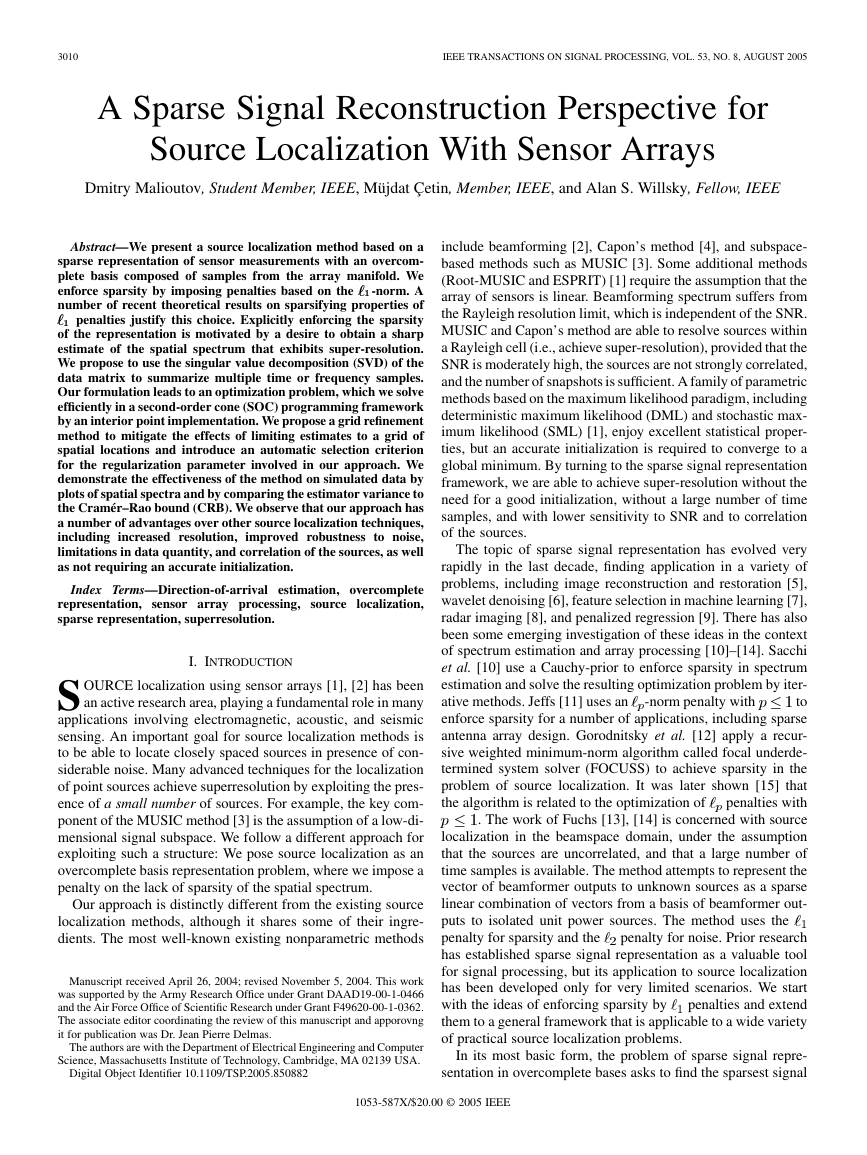
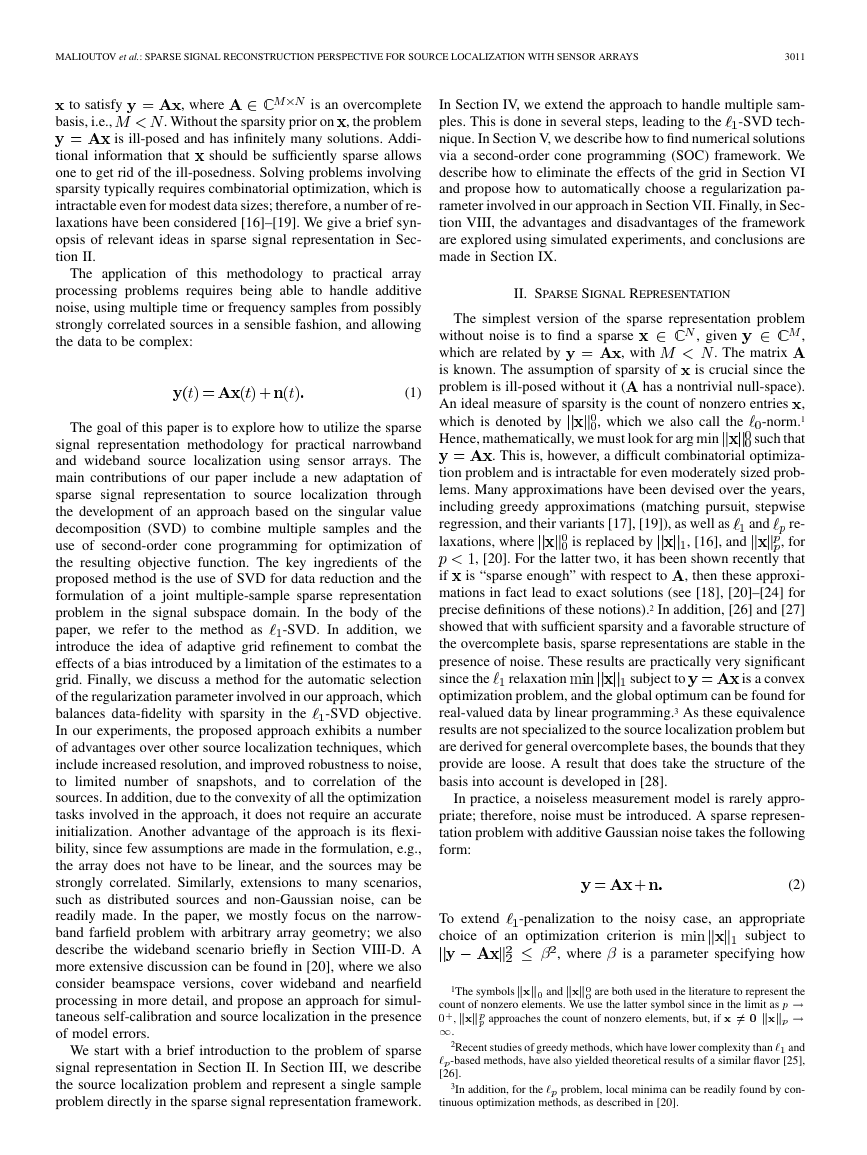
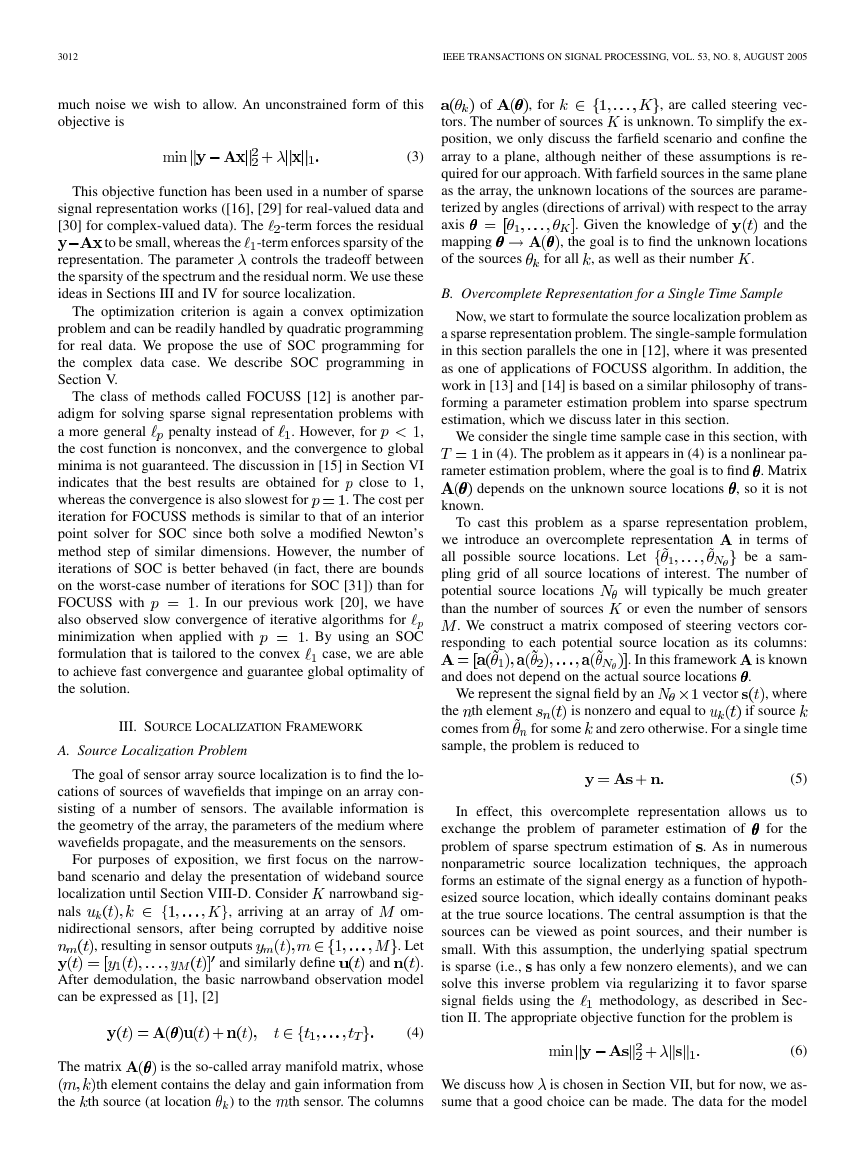
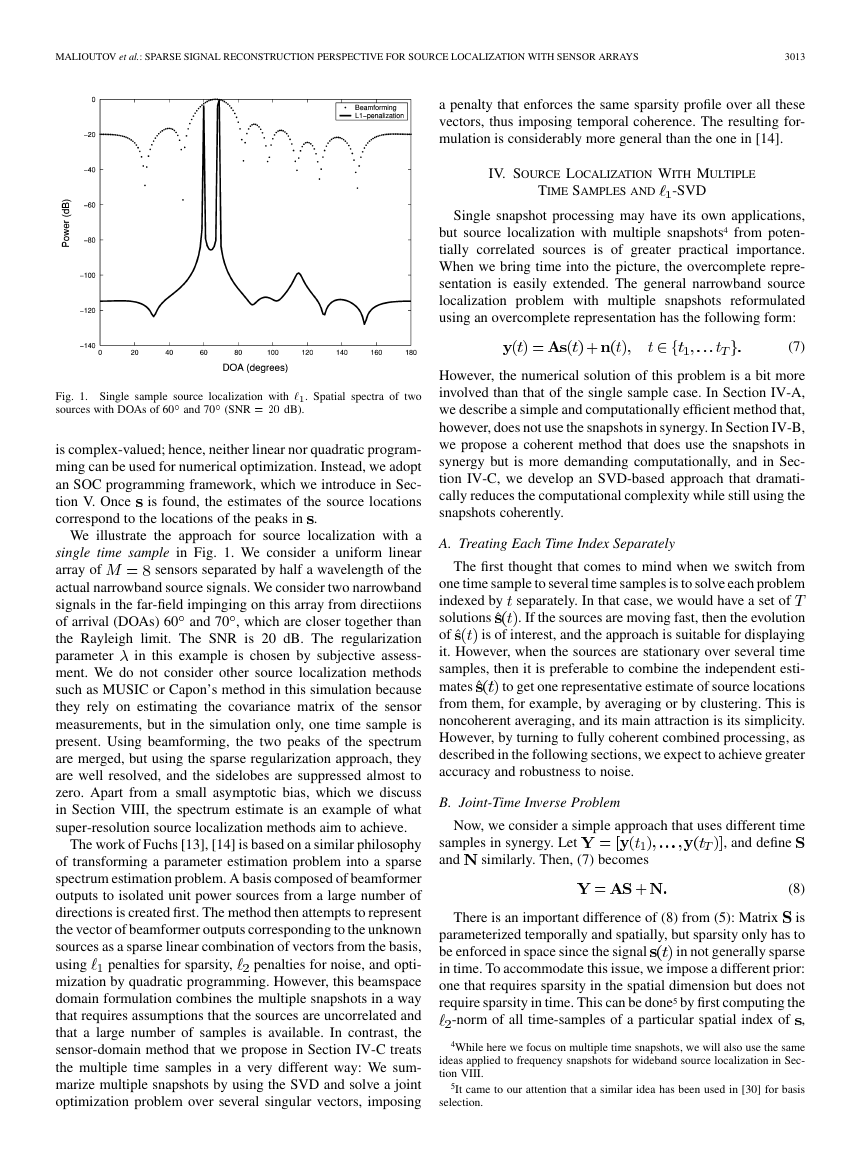
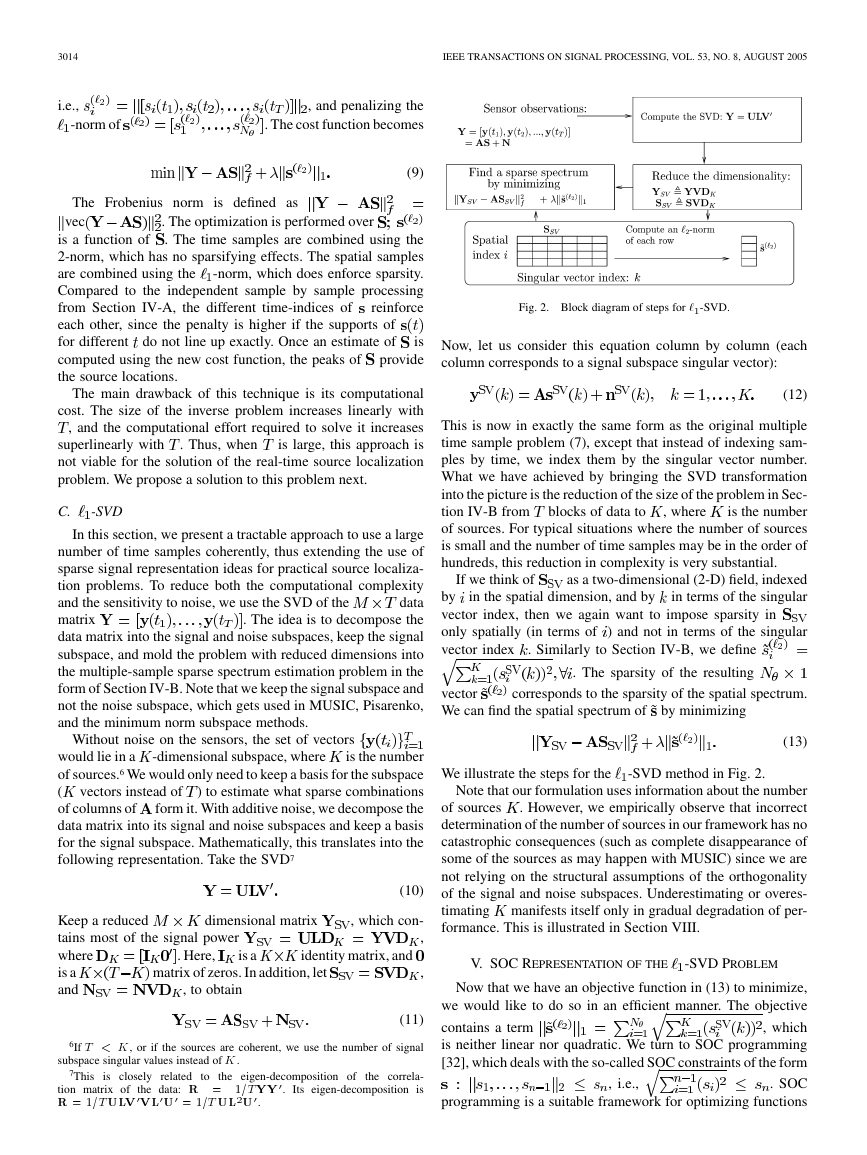
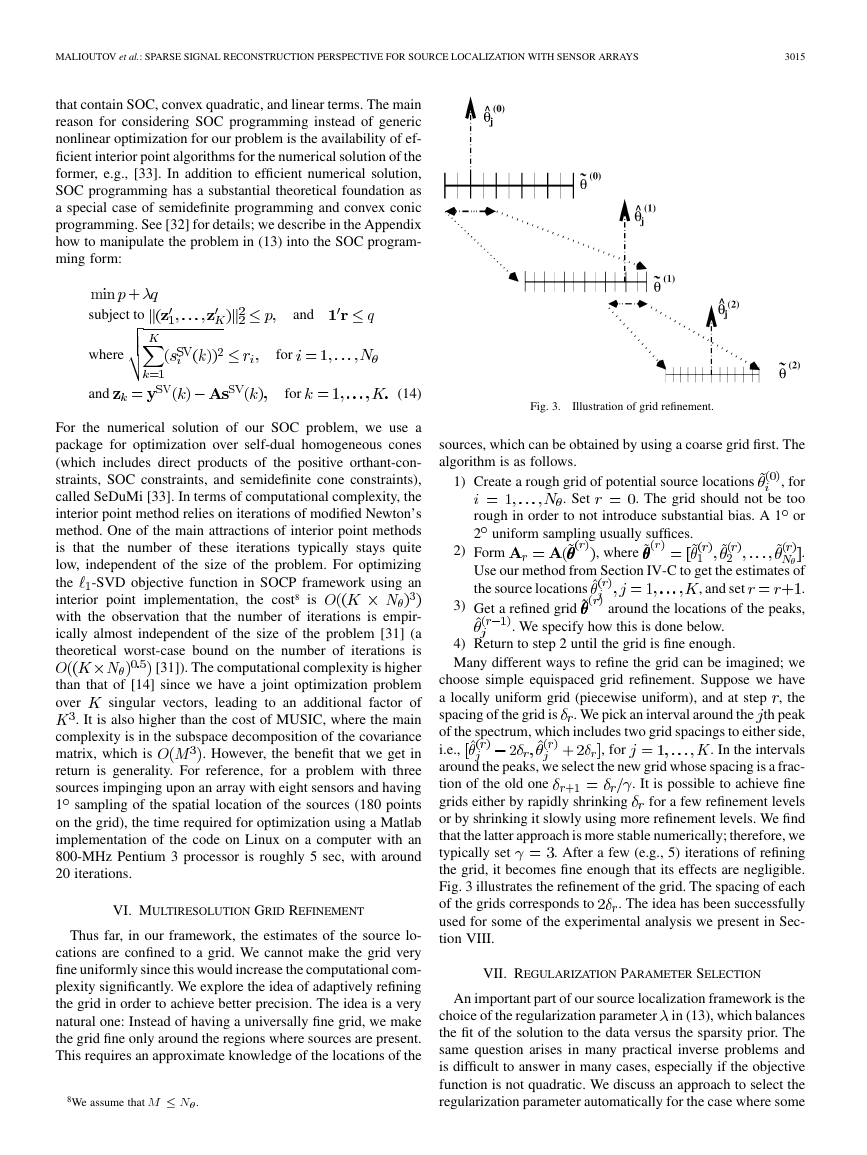
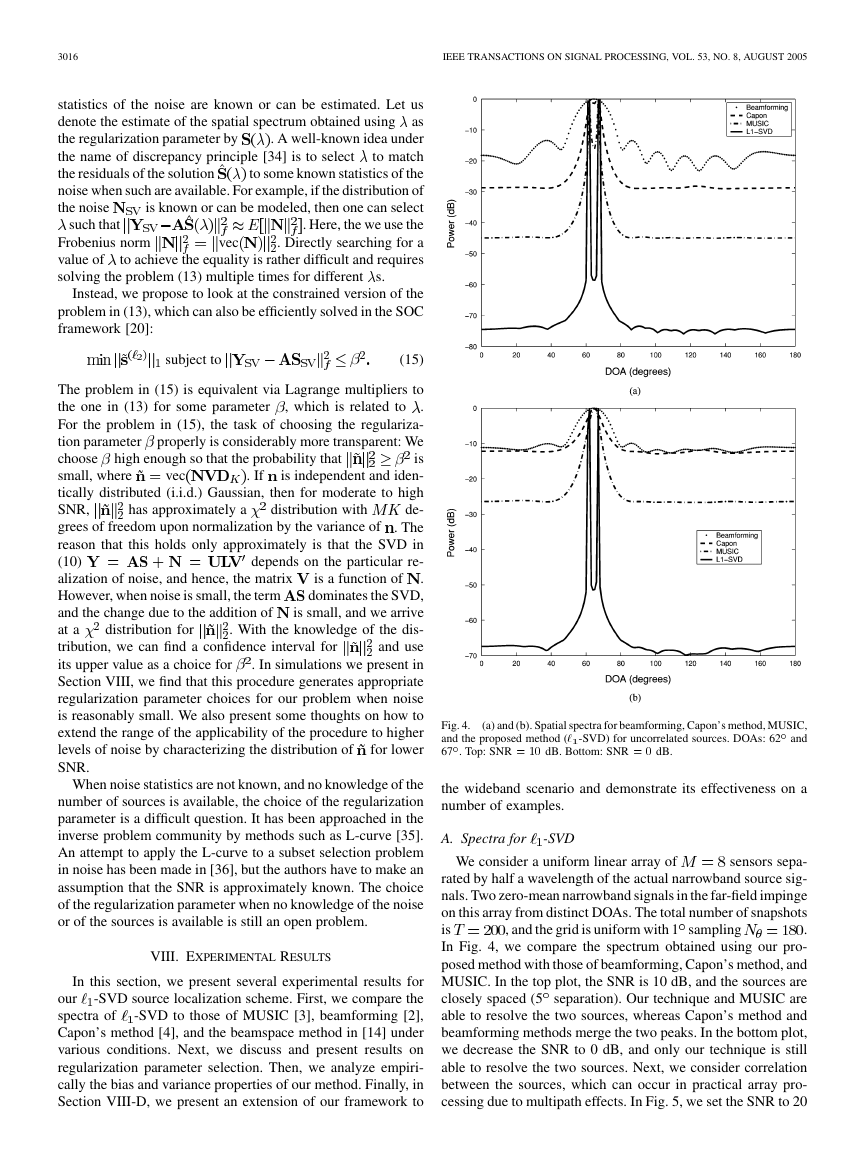









 2023年江西萍乡中考道德与法治真题及答案.doc
2023年江西萍乡中考道德与法治真题及答案.doc 2012年重庆南川中考生物真题及答案.doc
2012年重庆南川中考生物真题及答案.doc 2013年江西师范大学地理学综合及文艺理论基础考研真题.doc
2013年江西师范大学地理学综合及文艺理论基础考研真题.doc 2020年四川甘孜小升初语文真题及答案I卷.doc
2020年四川甘孜小升初语文真题及答案I卷.doc 2020年注册岩土工程师专业基础考试真题及答案.doc
2020年注册岩土工程师专业基础考试真题及答案.doc 2023-2024学年福建省厦门市九年级上学期数学月考试题及答案.doc
2023-2024学年福建省厦门市九年级上学期数学月考试题及答案.doc 2021-2022学年辽宁省沈阳市大东区九年级上学期语文期末试题及答案.doc
2021-2022学年辽宁省沈阳市大东区九年级上学期语文期末试题及答案.doc 2022-2023学年北京东城区初三第一学期物理期末试卷及答案.doc
2022-2023学年北京东城区初三第一学期物理期末试卷及答案.doc 2018上半年江西教师资格初中地理学科知识与教学能力真题及答案.doc
2018上半年江西教师资格初中地理学科知识与教学能力真题及答案.doc 2012年河北国家公务员申论考试真题及答案-省级.doc
2012年河北国家公务员申论考试真题及答案-省级.doc 2020-2021学年江苏省扬州市江都区邵樊片九年级上学期数学第一次质量检测试题及答案.doc
2020-2021学年江苏省扬州市江都区邵樊片九年级上学期数学第一次质量检测试题及答案.doc 2022下半年黑龙江教师资格证中学综合素质真题及答案.doc
2022下半年黑龙江教师资格证中学综合素质真题及答案.doc